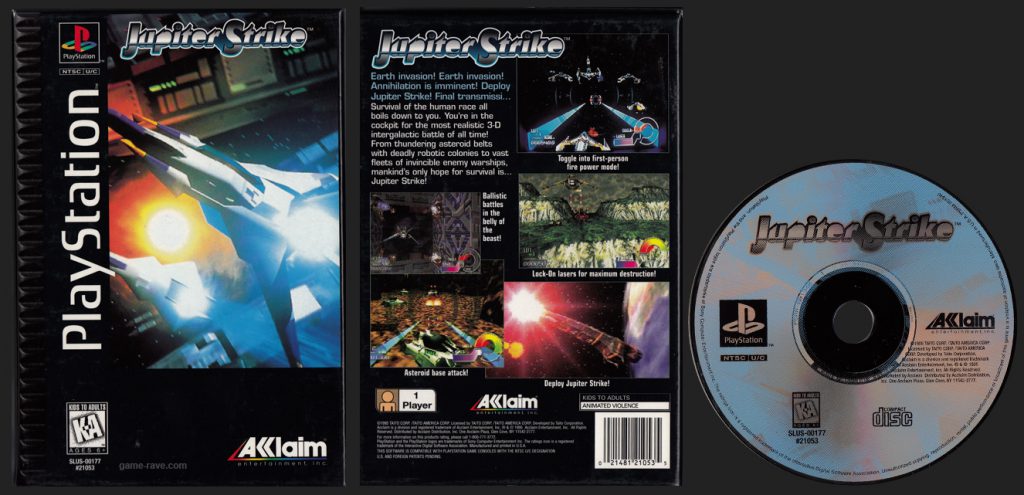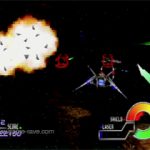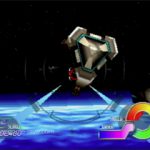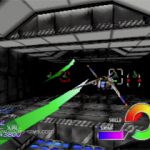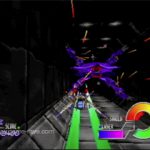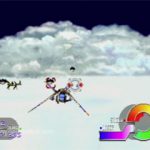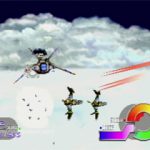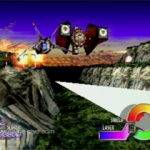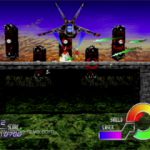| Genre: Shooter |
CDs: 1 |
|---|---|
| Publisher: Acclaim |
Released: December 6, 1995 |
| Developer: Taito |
UPC: 0 21481 21053 5 |
| Sony ID: SLUS-00177 |
PSRM: 001340 |
| Players: 1 Player |
Memory: None |
| Accessories: None |
|
| ESRB: Kids to Adults – Animated Violence |
|
| Box Copy:
Earth invasion! Earth Invasion! Annihilation is imminent! Deploy Jupiter Strike! Final transmissi… Survival of the human race all boils down to you. You’re in the cockpit for the most realistic 3-D intergalactic battle of all time! From thundering asteroid belts with deadly robotic colonies to vast fleets of invincible enemy warships, mankind’s only hope for survival is…Jupiter Strike!
|
|
Variants
- There are no known variants.
Misprints
It’s not so much a misprint, but the instruction manual incorrectly lists how to do a barrel roll. You only need to press L1 + R1 together at the same time.
Review
Taito has made a lot of amazing games in their lifetime, some of them unfairly addicting. Jupiter Strike sadly, is not one of those games.
Our featured title today is a 3rd person, auto-scrolling spaceship shooter from the house that Bubble Bobble built. Acclaim’s American release barely changes anything from the Japanese original, so purists can take comfort in knowing the experience is shared across the pond.
Gamers take control of the Coleoptere – a peculiarly named spacecraft that may be unintentionally referencing the real-world Coleopter. The latter is a 1950’s war machine that was essentially wingless. The homage may be unintentional as the game’s craft clearly has a wide set of wings. With this oddly named metal steed, they’ll have to face off against the evil Totenkloitz. Another possible wordplay, as Totenkopf is the German word for “Death’s Head”.
And let me tell you, Mr. Death’s Head is coming for the Earth after taking control of other planets in the solar system. Only a dashingly good pilot like yourself can save the universe and our lovely solar system from the oncoming horde. So begins Jupiter Strike, along with all the problems it carried over across the pond.
As mentioned earlier, it’s an auto-scrolling, forward-moving game, similar to everyone’s favorite classic StarFox. Hell, if we’re being honest with each other the back of the ship sort of looks like the Arwings. You have standard laser pew-pews and the early PlayStation’s trademark gimmick of homing lock-on lasers as well. The ship also has tilt and roll functions but oddly enough the roll is incorrectly listed in the manual. It tells you to press one shoulder button and then the other, but it’s really just pressing them at the same time. Besides the standard view, gamers can swap to a first-person view. A nifty gimmick that may or may not be preferred by some players.
Along with the basic controls are options for regular or inverted controls. Having now played it for the 6th or 7th time over the years, I think reversed controls are the way to go. The rest is just successfully shooting and dodging your way through the 8 stages. Which is where the rest of the game falls apart.
I guess there’s no other way to say it, but Jupiter Strike is just boring.
From the opening movie, there’s no sense of real impending doom or urgency. Sure, you’re witnessing whole armadas getting shredded to pieces, but it’s just…there. The launch sequence looks like someone just watched Silpheed and copied that, but slower. Even the music doesn’t seem appropriate for the vibe. There are only two options to speak of. Once in-game, the same template view screen is used for each level’s introduction. The opening music notes that welcome you into the world are monotone, muddy beats that sound like the first preprogrammed track on a new keyboard.
Playing through the stages isn’t necessarily bad, but they’re uneventful, cliche, and at times practically empty. When objects do begin to appear, the pop-in can be minorly jarring, only adding to the woeful experience. The problem here isn’t what is shown, but what isn’t. On their own, the stages feel nothing more but stereotypes played out in sequence. However, through a more forgiving review lens, and as a whole, the stages feel like great rough drafts. As if the level designers laid everything out for the first time and were never given the chance to finalize and refine it.
As mentioned before, the music is dull, repetitive, and drones on. At least, when you can hear it. Between all the weapon sound effects being able to just hear the music is a challenge. Sound effects are the standard fare, with nothing unique to call out.
Enemy patterns are designs that arguably fall in line with the backgrounds; they feel like first drafts rather than polished attack vectors. Half the time they don’t stay around long enough for you to fire or lock on, and the other half get so close to you that dodging their missile attacks is almost impossible.
This leads to the main flaw with Jupiter Strike. Graphics, audio, all of that can be forgiven if the gameplay holds up or if there’s just some gimmick that works. Taito provided nothing for the player to work towards. There are no power-ups. There are no extra lives – zero. You get 3 lives and that’s it. If you die, you start all over from the beginning of the stage, even if you were facing the boss. Considering the hilarious amount of attacks players face against just the first boss…it’s just…it’s just not worth it.
I shamelessly threw on a GameShark, slapped the Infinite Shield code on, and went about my way. Even with that code on, I still played as if I wasn’t impervious – and that allowed me to understand just what one would face reaching the end of the game on 3 lives with a full level reset for each loss. To put things in perspective, with infinite health I was able to finish Jupiter Strike in about 40 minutes. Prior I had spent about 3 hours not getting past the second stage boss, restarting the cycle every 3 deaths.
The final nail in the coffin is that just like how everything else is missing – Jupiter Strike appears to not have a high score table. So not only can you not earn anything in the game, but you can’t even have proof of your progress if you survived the ordeal.
At the end of the day, Jupiter Strike’s only claim to fame lay in its Programmer Cheats. There are two codes that change the camera view, including one where you’re above and slightly behind the ship. While it doesn’t help Jupiter Strike if combined with the release of RayForce, the hidden camera view reveals Taito’s first steps towards the absolute legendary shooters RayStorm and Ray Crisis years later.
After playing through the game multiple times over the years, my original review of Laughable at 3 out of 10 still stands. There’s nothing to save Taito’s early offering on the PlayStation but what it heralded was worth the once-through.
The Good
- It was something else to play in the early days.
- Gave us an unintentionally hidden preview of RayStorm
- The manual is rather interesting
The Bad
- Repetitive, boring music
- Uninspired designs
- Blandest of the bland gameplay
Final Score: 3 / 10 – Laughable
There really is nothing to save Jupiter Strike, but it’s clearly not the bottom of the barrel.
Screenshots
Videos
- There are currently no videos for this game.
Trivia
- If you can make it through a level without taking a hit you’ll earn 100,000 points.
- You earn 1 million points for defeating the final boss.
- Acclaim’s logo with the white burst references the laser beam shot in-game.
- In the manual enemies are named after military phonetics like Alpha, Bravo, Charlie, and more.
- Some stages have destructible objects like smaller asteroids and some small space station parts, but they don’t appear to affect anything.
- With an infinite shield GameShark code, the game can be beaten in 40 minutes or less.
- Japanese original name? Zeitgeist.
- There are only 3 lives in the game. That’s it.
- There are a lot of tiny nods to Nintendo’s StarFox being an influence on the game’s design.
- No Difficulty Levels.
- Despite keeping your score during the game, there is no high-score table.
- Jupiter Strike did so poorly at retail that Kay-Bee Toy Stores has brand new copies for $6.99 for years in their gaming cabinets.
Secrets
Not much to play with in the secrets department.
-
Top ViewPress Start to pause the game. Now press it again and hold Start for 10 seconds (the game will be unpaused). Then press L2 while still holding Start. Note that you’re still in 3D – the camera is just pulled way back. To undo, Pause, press and hold start, and press L2 again. No need for the 10-second wait.
-
Side ViewPress Start to pause the game. Now press it again and hold Start for 10 seconds (the game will be unpaused). Then press R2 while still holding Start. Note that you’re still in 3D – the camera is just pulled way back. To undo, Pause, press and hold start, and press R2 again. No need for the 10-second wait.






